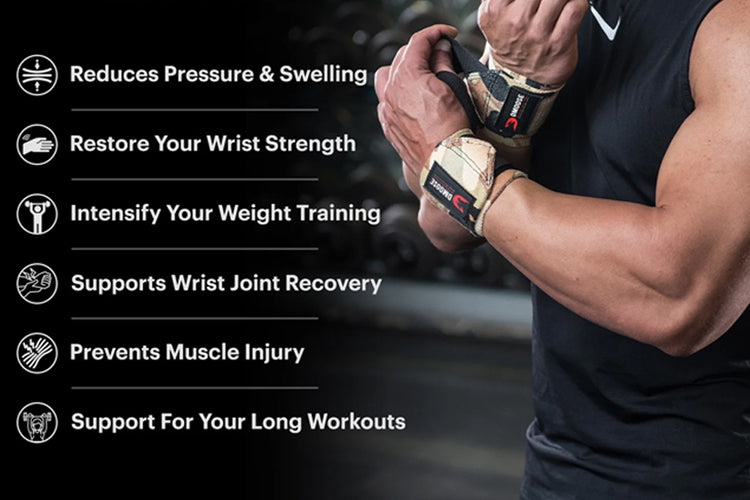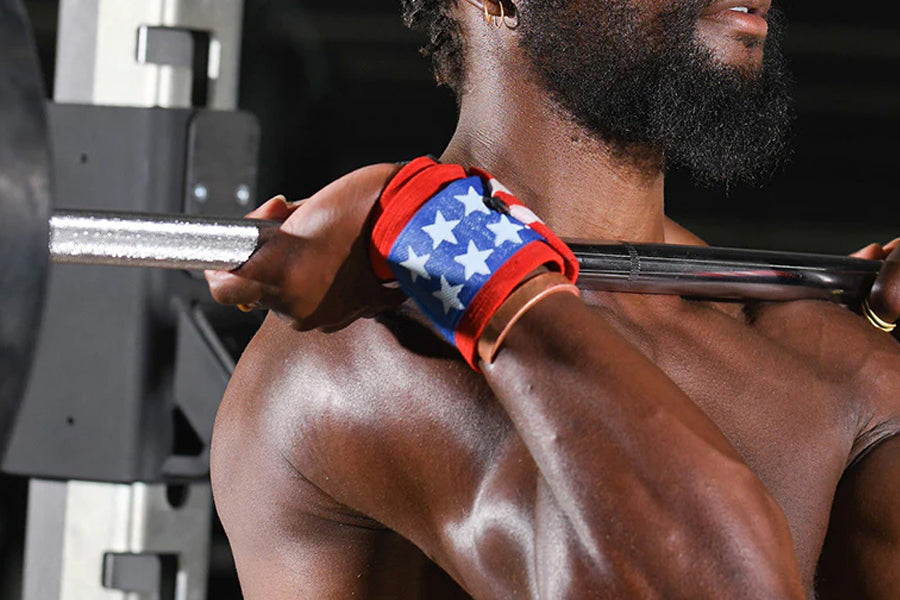Wrist wraps can be an essential accessory for weightlifters and bodybuilders, helping to provide support and stability to the wrist during heavy lifts. They are beneficial for exercises that strain the wrist, such as bench presses, deadlifts, and overhead presses.
Before beginning, ensure you have the correct wrist wrap size; they shouldn't be too tight or loose. There are several methods to fix them, so here we will run through how to put on wrist wraps safely and correctly - giving you confidence that your wrists can easily handle heavier lifts.
Choosing the Right Wrist Wraps
Before we dive into how to put on wrist wraps, it is essential to understand that not all wrist wraps are created equal. Many types of wrist wraps are available on the market, and choosing the right one can make all the difference in your workout.
When selecting wrist wraps, consider the following factors:
Length: Wrist wraps are available in lengths ranging from 12 to 36 inches. Longer wraps provide more support and stability but can be cumbersome to put on and take off. Shorter wraps are more comfortable and easier to use but offer less support.
Material: Wrist wraps are made of various materials, including cotton, nylon, and elastic. Cotton wraps are more rigid and provide excellent support, but they can be uncomfortable to wear for extended periods. Nylon and elastic wraps are more flexible and comfortable but provide less support.
Closure: Wrist wraps have different closure options, including Velcro, thumb loops, and buckle closures. Velcro closures are the most common and easiest to use, while thumb loops provide a more secure fit. Buckle closures are the most secure but can be challenging to adjust.
How to Put on Wrist Wraps

Putting on wrist wraps may seem simple, but there is a right and wrong way. Follow these steps to put on wrist wraps correctly:
Step 1: Hold the Wrap
Hold the wrap in one hand and locate the thumb loop or Velcro closure with the other hand. The thumb loop or Velcro closure should be on your wrist.
Step 2: Wrap the Wrist Wrap
Wrap the wrist wrap around your wrist, ensuring the thumb loop or Velcro closure is on the inside of your wrist. Make sure the wrap is snug but tight enough. You should be able to move your wrist comfortably.
Step 3: Wrap the Wrist Wrap Around Your Wrist
Wrap the wrist wrap around your wrist a second time, ensuring it covers the first wrap. The second wrap should be tighter than the first wrap and provide more support.
Step 4: Secure the Wrap
Secure the wrap by threading the thumb loop through the hole or pressing the Velcro closure firmly against the wrap. Make sure the wrap is snug and comfortable.
Step 5: Repeat on the Other Wrist
Repeat the same process on the other wrist.
How to Use Wrist Wraps Correctly
Now that you know how to put on wrist wraps properly, let's discuss how to use them correctly. Here are some tips to help you get the most out of your wrist wraps:
Tip 1: Use Them Only When Necessary
Wrist wraps should be used sparingly and only when necessary. Overusing wrist wraps can lead to weaker wrist muscles and joints, as they rely on the support provided by the wraps rather than strengthening themselves.
Tip 2: Don't Wrap Too Tight
Wrist wraps should be snug but not too tight. If they are too tight, they can restrict blood flow to the hand and fingers, leading to numbness and tingling.
Tip 3: Use Them for Heavy Lifts
Wrist wraps are most effective for heavy lifts that strain the wrist, such as bench presses, deadlifts, and overhead presses. For lighter lifts, wrist wraps are not necessary.
Tip 4: Use Them for More Extended Sets
If you are doing longer sets, wrist wraps can help prevent fatigue in the wrist muscles, allowing you to continue training for longer periods.
Tip 5: Use Them in Conjunction With the Proper Technique
Wrist wraps should never be used as a substitute for proper lifting technique. Always ensure your form and technique are correct before using wrist wraps.
Why Use Wrist Wraps?

Wrist wraps are an essential piece of gym gear for any serious weightlifter. They provide the added stability, support, and confidence needed to lift heavier weights safely and effectively. Here are some of the benefits of using wrist straps:
Improved Grip Strength
Wrist wraps help keep your hands firmly on the bar when lifting heavy weights, allowing you to maintain a better grip throughout the entire lift. This helps improve overall grip strength, which is essential for many types of exercise.
Reduced Risk of Injury
Wrist wraps provide extra support to prevent wrists from bending back during heavy lifts, reducing the risk of sprains and strains. They also help reduce the stress on muscles and joints, which can lead to injury when lifting heavy weights.
Improved Performance
With wrist wraps' added stability and support, you can lift more weight and achieve more significant results from your workout. This will help improve overall strength and performance.
Improved Stability
Wrist wraps also provide additional support for the wrists and arms, helping to keep them parallel with the floor during lifts. This improved stability allows you to maintain better form throughout your entire workout.
Related Article: How to Fix the Issue of Losing Your Grip During Lifting
How Can You Ensure Your Wrist Wraps Are the Perfect Fit?

When wearing wrist wraps, the tightness level can differ based on a few factors. Generally speaking, your wrap should be snug enough to have some limitations in motion but not entirely restricted in movement.
Additionally, the degree of tautness depends on what kind of wrap you use - extra stiff or standard flexibility - and which exercise is performed.
When Should I Make Sure My Wraps Are Securely Fit?
If you need maximum wrist support and don't require any flexibility in your wrists, then opt for a tight wrap. This is usually seen when stiff wraps are used - they're specifically designed to be worn tightly and provide incredible sturdiness under the usage of dumbbells and heavy weights. Powerlifters who compete at the highest levels rely on these specific wraps as their wrists won't budge even during rigorous activity.
When Is the Appropriate Time to Wear Wraps?
"Standard" wraps provide an ideal balance between support and flexibility. Constructed with elastic materials, you can adjust the tightness of the wrap to meet your specific needs; not too tight to restrict movement, but snug enough that you feel secure while lifting heavy weights. Whether squats or deadlifts, these wraps are designed to give you enough freedom so that no exercise feels out of reach!
This wrist wrap is incredibly versatile, allowing you to modulate its tightness depending on your goals. Tighten it for heavier lifts such as the bench press and overhead press, or simply adjust it slightly when performing more dynamic exercises requiring flexibility in your wrists, like snatches, cleans, and jerks.
When to Loosen Up Your Wraps?
Whether you are performing Olympic lifts or bodybuilding exercises, having the right level of wrist stability is essential. Flexible wraps provide just that-a balance between flexibility and support. Depending on your needs, you can select from softer to stiffer varieties of flexible wraps for optimal performance in any exercise routine.
Are You Sure Your Wrist Wrap Is Worn Properly?
You can tell if your wrist wrap is on correctly if you have good coverage over the joint with the material, the material is not unwrapping or moving around, and if you feel the wrap provides support without cutting off circulation.
To Guarantee Comprehensive Coverage for the Wrist Joint:
To properly secure the wrist, we recommend taking your initial wraps around the area just above and below the joint before repeating to cover both it and its surrounding regions.
To Ensure the Wrap Stays Secure and in Place:
The prior wrap remains partially underneath each new layer when securing your wrist. You should aim to have at least half the width covered by one another to guarantee that they don't unravel when wrapping them near the edges.
To Experience Total Comfort While Keeping Your Blood Flowing Freely:
When putting your wrist wrap on, ensure it's snug enough to provide support but not so tight that you start losing feeling or circulation in your hands.
FAQs
1. How to wear wrist wraps with a thumb loop?
To wear wrist wraps with thumb loops, follow these steps:
- Place your thumb through the thumb loop and hold the wrap.
- Wrap the fabric around your wrist and ensure it's snug but not too tight.
- Wrap the fabric around your wrist one or two more times.
- Pull the fabric through the thumb loop and tighten it until you feel secure.
2. How to put on wrist wraps without a thumb loop?
To put on wrist wraps without thumb loop, follow these steps:
- Hold the wrap in your hand and place it on your wrist.
- Wrap the fabric around your wrist and ensure it's snug but not too tight.
- Wrap the fabric around your wrist one or two more times.
- Once you have wrapped the fabric around your wrist, secure it with the Velcro closure.
3. What exercises can you do with wrist wraps?
Wrist wraps are suitable for any exercise that requires wrist stability and support. Some exercises that benefit from wrist wraps are heavy bench presses, military presses, squats, and deadlifts.
4. How to use wrist wraps without velcro?
Wrist wraps without Velcro can be tricky to use. Here’s how to use it:
- Hold the wrap in your hand and place it on your wrist.
- Wrap the fabric around your wrist and ensure it's snug but not too tight.
- Wrap the fabric around your wrist one or two more times.
- Once you have wrapped the fabric around your wrist, twist the ends of the wrap together until they are tight.
- Tuck the twisted end under the wrap to secure it in place.
Key Takeaways
Wrist wraps are a great accessory when you're hitting the gym. When used correctly and with the right tightness, they can help keep your wrists safe during exercise and protect them from injury.
Whether you're into Olympic lifts, powerlifting, or bodybuilding-wrist wraps have your back! Always ensure your wrap is snug enough to provide support but not so tight that it cuts off circulation. With this in mind, you'll get the most out of every workout session!
Once you find the perfect fit for your wrist wraps, you'll feel secure with each lift, knowing your wrists are fully supported. Most importantly, always remember to train safely and smartly!











